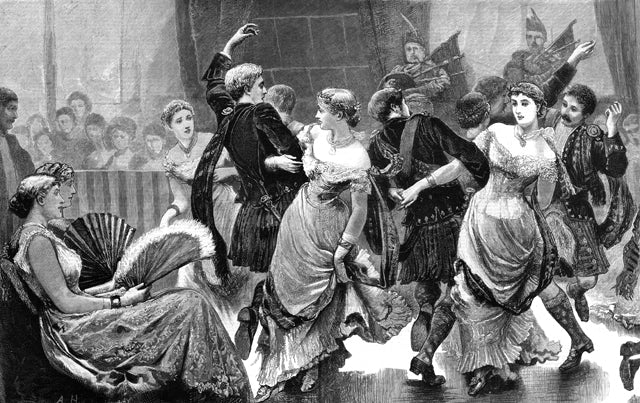Scottish Reel: The Ultimate Guide to the Traditional Scottish Dances

Scottish Reel: The Ultimate Guide to the Traditional Scottish Dances
Wedding season is here, and if you’re attending a Scottish wedding it’s never a bad idea to brush up on your knowledge of Scottish country dancing. Scottish reels are one of the most popular Scottish country dances, and we have the ultimate guide for traditional Scottish reels.
History of Traditional Scottish Reels
The Reel is a traditional Celtic dancing form. It's a type of country dance in which the dancers alternate between wandering figures and stationary "setting" movements. When dancing a Reel, there should be two or more couples in each set. Scottish Reels have been mentioned in history books since the 16th century. Except in the Scottish Highlands, where they vanished in the 17th century under the influence of the Presbyterian church before resurfacing in the Scottish Lowlands after 1700.However, Scottish reeling gained most of its popularity in the 18th century, when lairds hosted balls incorporating the dance genre.
Reels used to be associated with high society and were normally only seen at aristocratic festivities. Scottish reels were still popular among British military leaders, who have historically included many aristocrats.

How to Dance a Scottish Reel
The Gay Gordons, The Dashing White Sergeant, Hamilton House, the Duke of Perth, and the Reel of the 51st Division are among the 11,000 Scottish reels and dances recorded. With simple, repeating patterns, these are all quite simple to pick up.Reels are the most popular type of Scottish Country Dance when it comes to tempo classification. They are usually performed to music in 4/4 time. Most reels involve dancing with groups of 2 or 3 in figures of 8.
Scottish Reel Etiquette and Traditions
If you go to one, you might see some of the more prevalent Scottish reeling customs. These standards aren't set in stone, but you'll almost certainly see some of them.
Dance Cards
Dance cards, which were previously a mainstay of all types of social dances, are frequently used. Dance cards are useful because they function similarly to a schedule; they list the dances in rotation for the evening.
However, a dance card serves more than one purpose. Early in the evening, attendees should ask potential partners for specific dances. This method simplifies things and allows you to transition between dances without having to look for a partner each time.
Keep your dance card handy so you don't forget who you're dancing with.
Signalling the Next Dance
The band will play the first four bars of the next song to alert attendees to the next dance. A pause will ensue which allows dancers to find their partners and set themselves up for the next reel.
What to Wear
What to wear to a Scottish reel depends on the type of event. If the event specifies white tie, dresses are usually expected to be floor length, no more than four inches off of the floor. However, more casual reels are less strict on rules, and you’re able to wear what you feel comfortable with! Common accessories include fly plaids, a tartan sash and rosettes. Men will always wear a kilt to a reel.

It’s expected for all reels that you leave the heels and jewellery at home, as they can be a danger when dancing at such a fast pace.

 Check out our Yotpo Reviews
Check out our Yotpo Reviews